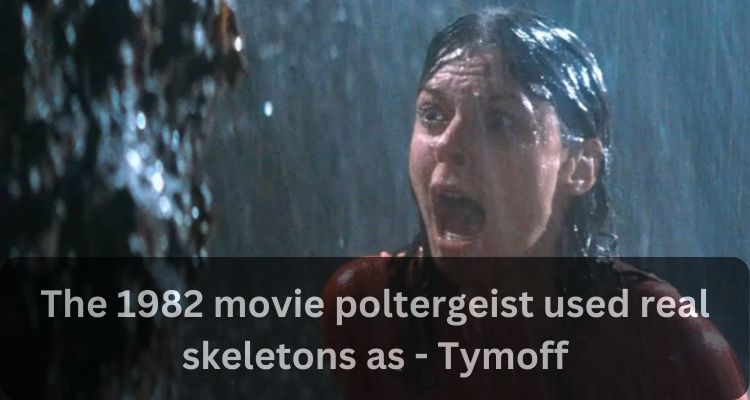Poltergeist was an instant classic horror flick released in 1988. Director Tobe Hooper wanted the movie to look as realistic as possible, which led him to use real skeletons as part of its props.
However, using real skeletons raises ethical issues which this article will explore and discuss whether the film was right to include real bones as props in its plot. Here we will discuss about the 1982 movie poltergeist used real skeletons as – tymoff.
The Buzz
Though Poltergeist is an iconic horror film, many may not realize that its filmmakers used real skeletons in several scenes. This decision caused some debate as some see this use of real bones as disrespectful to the dead; others have countered with arguments that this effect was necessary in creating their desired impact – regardless, real skeletons have become an integral part of its legacy.
Real skeletons were chosen for use in the movie due to filmmaking practices of the 1980s; at this time, realistic props were more difficult to come by; real skeletons proved easier than artificial ones for access. Moviemakers believed using real skeletons would add authenticity and make the film even more terrifying for audiences.
Occultists used real skeletons in a controversial film. There were no legal repercussions for filmmakers or production companies involved, yet recent years have witnessed critical dialogue about its themes and production history that prompt viewers to consider this work of fiction in more depth than before its controversial inclusion of real skeletons in it. This article looks at contemporary audiences’ responses to it given this contentious history of use of real skeletons.
In Poltergeist, the use of real human bones was justified as part of an immersive cinematic experience for audiences. Additionally, they were obtained from medical supply companies so no desecration or mistreatment occurred with these bones. Some have asserted that using such real bones was disrespectful towards those who died as well as their families.
The 1982 horror classic, Poltergeist: Filmed With Real Skeletons has become one of the most revered horror classics of all time. Its captivating storyline and groundbreaking special effects have long made it beloved among fans; but what truly made Poltergeist terrifying was filming using real human skeletons for its terrifying special effects – something which caused an ethical controversy within Hollywood filmmaking but remains an important legacy element.
The Movie’s Legacy
Poltergeist is an iconic horror film that has left an indelible mark on many minds. Famed for its terrifying atmosphere and special effects, this movie’s use of real skeletons in certain scenes caused much debate; some felt desecration while others saw this practice as essential in creating a frightening atmosphere for its narrative.
This film takes place in a suburban neighborhood where residents are being terrorized by an evil spirit, who seeks to scare off residents by moving objects and making strange noises, while at times trying to abduct one of their children – with one scene featuring real skeletons showing Carol Anne Freeling (Heather O’Rourke).
While the use of real skeletons for this movie was highly contentious, they proved effective at creating an unnerving atmosphere. Director Tobe Hooper explained that they were rented from a medical supply company before being cleaned afterwards for use in filming. Hooper’s controversial decision has inspired numerous movies to use similar approaches in their storytelling.
Though controversial due to its depiction of real skeletons in the movie, “Ghostbusters” remains very popular and now considered a classic. Millions have watched it and its influence can be felt both when considering ghosts as well as life after death.
Though using real skeletons has caused controversy, they remain an integral part of movie sets today. Their presence helps create more realistic films with chilling atmospheres while making actors seem more convincing. But it should be remembered that using real skeletons does not guarantee more accurate films; using visual effects and prop design can also enhance scenes’ realism.
The Ethical Issues
Horror movie viewers often encounter unsettling truths that remain unsaid. Not only are these haunting tales captivating, but they often provoke conversations on moral and ethical implications when tangible elements such as real skeletons are used to create authentic horror. This section delves into these discussions in greater depth by exploring reactions and emotions among cast and crew and exploring any wider implications from using real skeletons as horror props.
Steven Spielberg produced and Tobe Hooper directed the 1982 movie Poltergeist, and there have been persistent rumors since that its creators employed human skeletons as props in order to create an immersive and terrifying film experience. Although these claims remain speculations, they could potentially be plausible given that practical effects were still essential and advances in special effects technology were significant during that era of filmmaking. Furthermore, special effects artist Craig Reardon from Poltergeist was clear about their position regarding this matter, emphasizing all skeleton props were created using state-of-the-art materials when creating their creations.
Real skeletons pose an ethical and moral conundrum when used in films. While real bones add authenticity, they also spark moral discussions related to respecting deceased individuals, audience sensibilities and the ethics of entertainment industry practices.
These controversies illustrate the necessity for strict guidelines and standards within the film industry to protect human dignity while maintaining cinematic authenticity. Furthermore, they demonstrate the necessity of upholding an active sense of responsibility throughout production, from concept development through final product delivery.
Since that incident occurred, rules have been put in place to prohibit filmmakers from using real skeletons as props in filmmaking. Instead, plastic-made versions are now used instead, making them much cheaper to work with and more straightforward when disposing of after use.
Tymoff’s Perspective
Poltergeist’s story has long captivated and entertained audiences, thanks to its special effects and captivating storytelling that have cemented its status as a classic horror flick. However, its production process sparked considerable debate and raised ethical concerns for filmmakers involved.
Tobe Hooper and Steven Spielberg employed real skeletons in order to create an unsettling atmosphere and establish a connection between supernatural elements and real world settings. While some found this controversial, it did add depth and resonance to the film as a whole. Furthermore, using actual bones helped connect supernatural beings with humanity on screen.
Real skeletons were used in the swimming pool scene to create an unsettling ambience, further enhanced with props, visual effects and optical compositing techniques for maximum effect and to make the scene seem both terrifying and believable.
Even after controversy surrounding the film’s use of real skeletons in its plot, neither its producers or cast faced legal or ethical ramifications for using real remains as part of its plot. Instead, it prompted discussions regarding how real bodies should be handled during filmmaking.
This film followed the Freeling family as they felt that spirits were haunting their suburban home and Carol Anne was communicating with these spirits via television, prompting her parents to seek assistance from parapsychologists. The movie succeeded in creating an atmosphere of fearful suspense among its viewers and has served as a model for future films that take similar approaches.
As the film gained in popularity, many began to believe that it was cursed and had an undisclosed link to supernatural forces. These beliefs were further amplified when cast members Heather O’Rourke and Dominique Dunne experienced personal tragedies that intensified such suspicions; eventually becoming part of its legacy that is still widely discussed today.
Poltergeist made waves in filmmaking by its use of real skeletons for dramatic purposes and its subsequent controversy, which continues to shape how filmmakers approach authenticity and ethical considerations today. To know more about the 1982 movie poltergeist used real skeletons as – tymoff just follow us.


























+ There are no comments
Add yours